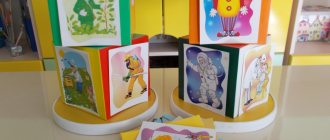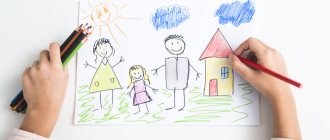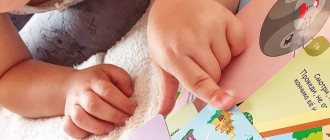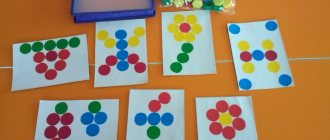Types of didactic games
| Types of games | Description |
| Games with objects (toys) | This type of game is based on the interaction of children with objects. In this way, children learn to compare objects, establish similarities and differences between them, and become familiar with the properties of objects, size, and color. |
| Board-printed games | With the help of these games, the child gets acquainted with the world around him, the world of animals and plants, the emotional world, etc. Printed board games can be presented in the form of: “lotto”, “dominoes”, “paired pictures”. With their help, you can successfully develop speech skills, mathematical abilities, logic, attention, learn to model life patterns and make decisions, and develop self-control skills. |
| Word games | Word games are an effective method of fostering independent thinking and speech development in children. They are built on the words and actions of the players; children independently solve various mental problems: they describe objects, highlighting their characteristic features, guess them from the description, find similarities and differences between these objects and natural phenomena. |
Next, I invite you to get acquainted with the printed board games that I have developed for working with preschool children.
results
Nowadays, many preschool children cannot independently talk coherently and in sufficient detail about what they have drawn. Constructing a dialogue also causes difficulties. The children limit themselves to simple one-syllable sentences: “House, sunshine, I’m going with my mother...” In such a situation, “Droodles” turn out to be very valuable assistants in the work of a teacher-psychologist in a kindergarten. At the first stages of the game, of course, small difficulties arise: the children, out of habit, saw only “stripes, circles, triangles...” in the droodle drawings. But we didn’t give up, we played with these “doodles” again and again. We looked at the same pictures several times in a row. And every time the children see more and more options, they talk more and more about what they saw. Many began to suggest expanding the picture to get a completely different image. Gradually I began to introduce new droodles. And the children were already actively involved in the game.
The next stage of our game with the children was drawing pictures from the proposed doodles. I handed out the droodles I drew, and the kids drew something of their own. The result was very interesting pictures, about which we talked for a long time (Fig. 2).
Figure 2. Options for preschoolers to work on Doodle No. 2
Everyone wanted to talk about their work, what they saw, what they decided to depict. Over time, we moved to a new level of games and the guys began to draw doodles themselves.
Results:
- development of imaginative and logical thinking in children,
- expanding consciousness, reducing the fear of taking initiative,
- increasing intellectual level,
- development of imagination,
- development of communication skills and speech in general, since while drawing I talk about what I am drawing. When working with a child in pairs, you cannot do without communication.
After several lessons using doodles, a preschool child overcomes stiffness and shyness, and gradually develops logic of thinking, speech and general initiative.
This technique has no age restrictions, helps adults and children communicate, and provides an opportunity to dream and laugh together.
Let's learn together to see the unusual in the ordinary!
Didactic game "Locomotive"
The game is aimed at developing visual-figurative thinking, elements of logical thinking, the ability to group objects according to their functional purpose, select generalizing words, develop visual memory, and develop attention.
The kit includes:
- 8 trains;
- a set of trailers with wild animals, pets, fruits, vegetables, clothes, dishes, toys, furniture.
From 1 to 8 children can take part in the game. The game is aimed at children aged 4 to 7 years.
Rules of the game: The trailers are laid out in front of the child, upside down. Then the teacher suggests taking one trailer at a time and attaching them to a specific train. It is discussed in advance with the child that carriages, for example, with domestic animals, will be attached to the blue train, and to the orange train, with wild animals (instead of animals, you can use another option for classification, for example, fruits and vegetables). Next, the teacher can ask the child to close his eyes, and at this time turn over some trailers and invite the child to remember what was in these trailers, or he can swap the trailers and ask what has changed.
Downloaded: 1554, size: 1.7 MB, date: April 14. 2020
Psychological games for preschool children
Game-based training for preschool children should be short in duration, since children’s attention dissipates very quickly. It is preferable to play three or more games in one lesson with breaks of 5-15 minutes between them.
Baby dragon biting its own tail
The purpose of this game is to get rid of obsessive neuroses and deep-rooted fears. It is necessary to select musical accompaniment in advance, and the playlist should consist mainly of cheerful major songs and melodies. The game is played as follows: children line up one after another in the form of a living chain. Each of the guys should hold on to the shoulders of his friend in front. The task of the first baby, personifying the head of the dragon, is to catch the child who closes the chain as quickly as possible.
Exercises to improve self-control
Psychological training is important for children to help them deal with negative emotions. Preschool children should be reminded as often as possible about the destructive nature of anger, and if they are overcome by anger, they need to pause, then take a deep breath and exhale. Then, standing up straight, you need to count to 10 in your head and smile from ear to ear. Anger and irritability cannot tolerate calm and goodwill. At the same time, it is necessary to remind the child that only by learning to direct his own emotions in a constructive direction will he be able to become an adult and independent person.
Didactic game “Hide the toy”
The game is aimed at developing attention, memory, and developing the ability to correlate colors.
The kit includes:
- 6 houses depicting toys;
- 6 windows.
The game is intended for individual use and is aimed at children aged 3 years and older.
Rules of the game: Houses are laid out in front of the child in any order and they are asked to first name the toys shown in the window, and then cover these windows with a card of the corresponding color. Then the adult asks the child to remember in which house the ball, doll, etc. is hidden.
Downloaded: 1409, size: 480.1 KB, date: April 14. 2020
Card index of games of a teacher-psychologist
ANYA KANDAUROVA
Card index of games of a teacher-psychologist
Games with anxious children aimed at developing a sense of trust and self-confidence in children
"Caterpillar"
Purpose: the game teaches trust. Almost always the partners are not visible, although they can be heard. The success of everyone’s promotion depends on everyone’s ability to coordinate their efforts with the actions of other participants. “Guys, now you and I will be one big caterpillar and we will all move around this room together. Form a line, place your hands on the shoulders of the person in front. Place a balloon or ball between the stomach of one player and the back of the other. Touching the balloon (ball) with your hands is strictly prohibited! The first participant in the chain holds his ball at outstretched arms.
Thus, in a single chain, but without the help of hands, you must follow a certain route.” For those watching: pay attention to where the leaders are located, who regulates the movement of the “living caterpillar”.
"Magic Chair"
Goal: to help increase the child’s self-esteem and improve relationships between children. This game can be played with a group of children for a long time. First, an adult must find out the “history” of each child’s name - its origin, what it means. In addition, you need to make a crown and a “Magic Chair” - it must be high. The adult conducts a short introductory conversation about the origin of the names, and then says that he will talk about the names of all the children in the group (the group should not be more than 5-6 people, and it is better to name the names of anxious children in the middle of the game. The one whose name is told becomes King Throughout the entire story about his name, he sits on a throne wearing a crown.
At the end of the game, you can invite the children to come up with different versions of his name (gentle, affectionate). You can also take turns saying something good about the king.
"Bunnies and Elephants"
Goal: to enable children to feel strong and courageous, to help increase self-esteem. “Guys, I want to offer you a game called “Bunnies and Elephants.” At first, you and I will be little bunnies. Tell me, when a hare feels danger, what does it do? That's right, he's shaking. Show him how he shakes. He purses his ears, shrinks all over, tries to become small and unnoticeable, his tail and paws are shaking,” etc. Children show. “Show me what bunnies do if they hear a person’s steps?” Children scatter around the group, class, hide, etc. “What do bunnies do if they see a wolf? “The teacher plays with the children for several minutes. “And now you and I will be elephants, big, strong, brave. Show how calmly, measuredly, majestically and fearlessly elephants walk. What do elephants do when they see a person? Are they afraid of him? No. They are friends with him and, when they see him, they calmly continue on their way. Show me how. Show what elephants do when they see a tiger. “Children pretend to be a fearless elephant for a few minutes.
After the exercise, the guys sit in a circle and discuss who they liked to be and why.
"Change of Rhythms"
Goal: to help anxious children join the general rhythm of work and relieve excessive muscle tension. If the teacher wants to attract the attention of the children, he begins to clap his hands and count loudly, in time with the clapping: one, two, three, four. The children join in too, clapping their hands together and counting in unison: one, two, three, four. Gradually, the teacher, and after him the children, clap less and less, counting more and more quietly.
Outdoor games with aggressive children
"Name-calling"
Goal: remove verbal aggression, help children express anger in an acceptable form.
Tell the children the following: “Guys, passing the ball around, let’s call each other different harmless words (the condition of what names can be used is discussed in advance. These can be the names of vegetables, fruits, mushrooms or furniture). Each appeal should begin with the words: “And you,... , carrot!" Remember that this is a game, so we won’t be offended at each other. In the final circle, you should definitely say something nice to your neighbor, for example: “And you,... Sun!"
The game is useful not only for aggressive, but also for touchy children. It should be carried out at a fast pace, warning the children that this is only a game and they should not be offended by each other.
"Two Rams"
Goal: relieve non-verbal aggression, provide the child with the opportunity to “legally” throw out anger, relieve excessive emotional and muscle tension, and direct the children’s energy in the right direction.
The teacher divides the children into pairs and reads the text: Early on, two rams met on a bridge.” The participants in the game, with their legs spread wide apart, their torsos bent forward, rest their palms and foreheads against each other. The task is to confront each other without budging for as long as possible. You can make the sounds “Bee-e-e”. It is necessary to follow “safety precautions”, carefully monitor so that the “rams” do not break their foreheads.
"Good Animal"
Goal: to promote the unity of the children's team, teach children to understand the feelings of others, provide support and empathy.
The presenter says in a quiet, mysterious voice:
“Please stand in a circle and hold hands. We are one big, kind animal. Let's listen to how it breathes! Now let's breathe together! When you inhale, take a step forward; when you exhale, you take a step back. Now, when you inhale, take 2 steps forward, and when you exhale, take 2 steps back. Inhale - 2 steps forward. Exhale - 2 steps back. This is how the animal not only breathes, its big, kind heart beats just as clearly and evenly. A knock is a step forward, a knock is a step back, etc. We all take the breath and heartbeat of this animal for ourselves.”
"Tuh-tibi-duh"
Goal: removing negative moods and restoring strength.
“I will tell you a special word in confidence. This is a magic spell against bad mood, against resentment and disappointment. For it to really work, you need to do the following. Now you will start walking around the room without talking to anyone. As soon as you want to talk, stop in front of one of the participants, look into his eyes and three times, angrily, say the magic word: “Tuh-tibi-duh.” Then continue walking around the room. From time to time, stop in front of someone and say this magic word angrily again.
For the magic word to work, you need to speak it not into emptiness, but looking into the eyes of the person standing in front of you.
There is a comical paradox in this game. Although children are supposed to say the word "Tuh-tibi-duh" angrily, after a while they can't help but laugh.
“Ask for a toy” - verbal option
Goal: to teach children effective ways of communication.
The group is divided into pairs, one of the pair members (participant 1) picks up an object, for example, a toy, notebook, pencil, etc. The other participant (participant 2) must ask for this item. Instructions to participant 1: “You are holding a toy in your hands (a notebook, a pencil, which you really need, but your friend also needs it. He will ask you for it. Try to keep the toy with you and give it only if you really need it. you will want to do it." Instructions to participant 2: “When choosing the right words, try to ask for the toy in such a way that they will give it to you.” Then participants 1 and 2 change roles.
“Ask for a toy” - non-verbal option
Goal: teaching children effective ways of communication.
The exercise is performed similarly to the previous one, but using only non-verbal means of communication (facial expressions, gestures, distance, etc.). After conducting both versions (verbal and non-verbal), you can discuss the exercise. Children in a circle can share their impressions and answer the questions: “When was it easier to ask for a toy (or other item?”), “When did you really want to give it away? What words should you have said?” This game can be repeated several times (on different days , it will be useful especially for those children who often conflict with their peers, since in the process of performing the exercise they acquire effective interaction skills.
"Walking with a Compass"
Goal: to develop in children a sense of trust in others.
The group is divided into pairs, where there is a follower (“tourist”) and a leader (“compass”). Each follower (he stands in front, and the leader behind, with his hands on his partner’s shoulders) is blindfolded. Task: go through the entire playing field forward and backward. At the same time, the “tourist cannot communicate with the “compass” on a verbal level (cannot talk to it). The leader, by moving his hands, helps the follower keep the direction, avoiding obstacles - other tourists with compasses. After finishing the game, children can describe how they felt when they were blindfolded and relying on their partner.
"I see."
Goal: to establish a trusting relationship between an adult and a child, to develop the baby’s memory and attention.
Participants, sitting in a circle, take turns naming the objects that are in the room, beginning each statement with the words: “I see.” “You cannot repeat the same subject twice.
"Bunnies"
Goal: to give the child the opportunity to experience a variety of muscle sensations, to teach them to focus on these sensations, distinguish and compare them.
An adult asks the children to imagine themselves as funny bunnies in a circus, playing imaginary drums. The presenter describes the nature of the physical actions - strength, pace, sharpness - and directs the children's attention to awareness and comparison of the muscular and emotional sensations that arise.
For example, the presenter says: “How hard the bunnies beat on the drums! Do you feel how tense their paws are? You feel how firm the paws are and don’t bend!
Like sticks! Feel how the muscles in your fists, arms, even your shoulders tense! But there is no face! The face is smiling, free, relaxed. And the tummy is relaxed. Breathing. And the fists are intensely knocking. What else is relaxed? Let’s try knocking again, but slower, to catch all the sensations.” In addition to the “Bunnies” exercise, it is recommended to carry out muscle relaxation exercises, which are described in detail in the section “How to play with anxious children.”
"Pushers"
Goal: to teach children to control their movements.
Say the following: “Get into pairs. Stand an arm's length apart from each other. Raise your arms to shoulder height and rest your palms on your partner's palms. At the leader’s signal, start pushing your partner, trying to move him from his place. If he moves you, return to your starting position. Step one foot back and you will feel more stable. Anyone who gets tired can say: “Stop.” From time to time, you can introduce new variations of the game: pushing, crossing your arms; push your partner only with your left hand; pushing back to back.
"Zhuzha"
Goal: to teach aggressive children to be less touchy, to give them a unique opportunity to look at themselves through the eyes of others, to be in the shoes of the one they themselves offend, without thinking about it.
“Zhuzha” sits on a chair with a towel in her hands. Everyone else is running around her, making faces, teasing her, touching her. “Zhuzha” endures, but when she gets tired of all this, she jumps up and starts chasing the offenders, trying to catch the one who offended her the most, he will be “Zhuzha”.
An adult should ensure that the “teasing” is not too offensive.
"Chopping Wood"
Goal: to help children switch to active activity after long sedentary work, feel their accumulated aggressive energy and “spend” it during play.
Say the following: “How many of you have ever chopped wood or seen adults do it? Show how to hold an axe. In what position should the arms and legs be? Stand so that there is some free space around. We'll chop wood. Place a piece of log on a stump, lift the ax above your head and bring it down with force. You might even scream, “Ha!”
To play this game, you can break into pairs and, falling into a certain rhythm, hit one lump in turn.
"Golovoball"
Goal: to develop cooperation skills in pairs and trios, to teach children to trust each other.
Say the following: “Get into pairs and lie on the floor opposite each other. You need to lie on your stomach so that your head is next to your partner's head. Place the ball directly between your heads. Now you need to pick it up and stand up yourself. You can only touch the ball with your heads. Rise up gradually, first on your knees and then on your feet. Walk around the room.” For children 4-5 years old, the rules are simplified: for example, in the starting position you can not lie down, but squat or kneel.
"The Dragon"
Goal: to help children with communication difficulties gain confidence and feel like part of a team.
The players stand in a line, holding each other's shoulders. The first participant is the “head”, the last one is the “tail”. The “head” should reach out to the “tail” and touch it. The dragon's "body" is inseparable. Once the "head" grabs the "tail", it becomes the "tail". The game continues until each participant plays two roles.
"Airbus"
Goal: to teach children to act coherently in a small group, to show that the mutual friendly attitude of teammates gives confidence and calm.
“How many of you have flown on an airplane at least once? Can you explain what keeps a plane in the air? Do you know what types of airplanes there are? Would any of you want to be a Little Airbus? The rest of the guys will help the Airbus “fly”. One of the children (optional) lies belly down on the carpet and spreads his arms to the sides, like the wings of an airplane. Three people stand on each side of him. Have them squat down and slide their hands under his legs, stomach and chest. On the count of three, they simultaneously stand up and lift the Airbus off the field. So, now you can quietly carry the Airbus around the room. When he feels completely confident, have him close his eyes, relax, “fly” in a circle and slowly “land” again on the carpet.
When the Airbus is “flying,” the presenter can comment on its flight, paying special attention to accuracy and respect for it. You can ask Airbus to independently select those who will carry it. When you see that the children are doing well, you can “launch” two Airbuses at the same time.
"Paper Balls"
Goal: to give children the opportunity to regain vigor and activity after they have been doing something for a long time while sitting, reduce anxiety and tension, and enter a new rhythm of life.
Before starting the game, each child must crumple a large sheet of paper (newspaper) to form a tight ball.
“Please divide into two teams and have each of them line up so that the distance between the teams is approximately 4 meters. At the leader's command, you begin to throw balls towards the opponent's side. The command will be like: “Get ready! Attention! Let's start!
The players of each team try to throw the balls on their side to the opponent’s side as quickly as possible. When you hear the command “Stop!”, you will need to stop throwing balls. The team with the fewest balls on the floor wins. Please do not run across the dividing line.” Paper balls can be used more than once.
Games with clothespins “Find a pair”
The game is aimed at developing observation, attention, accuracy of visual perception, and the ability to select paired pictures according to their meaning.
Before starting the game, the circles must be cut out and attached to clothespins; the game discs are also cut out.
The kit includes:
- 4 game discs;
- 32 circles from images pictures.
Rules of the game: The player is offered a disk to which he must attach clothespins with corresponding pictures according to their meaning. The following tasks are offered for the game: “Find the shadow”, “Mom and baby”, “Tops and roots”, “Find a pair”.
Downloaded: 1320, size: 1.3 MB, date: April 14. 2020







